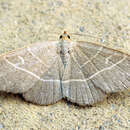Biology
provided by Arkive
A single-brooded species, adults fly in June and July. Caterpillars can be found between August and early October feeding on withered oak and beech leaves, either on the ground, on fallen branches, or on damaged branches still attached to the tree (2). The overwintering stage is the pupa (2).
Conservation
provided by Arkive
A Species Action Plan has been produced for the Olive Crescent moth, which aims to maintain the present populations of the species, and has proposed a programme of monitoring (1).
Description
provided by Arkive
Adults of the rare Olive Crescent moth are orange-brown in colour with whitish cross-lines (5).
Habitat
provided by Arkive
All UK populations occur in woodlands (1).
Range
provided by Arkive
In the UK this species occurs in a small and declining population in the Chilterns in Buckinghamshire, and in two populations in Essex (1). The range extends through most of Europe to Siberia, northern Iran and China (1).
Status
provided by Arkive
Classified as Rare in Great Britain (1).
Threats
provided by Arkive
It is thought that changing woodland structure and new management techniques have affected the species (1).
Trisateles emortualis
provided by wikipedia EN
Trisateles is a monotypic moth genus of the family Erebidae described by Tams in 1939. Its only species, Trisateles emortualis, the olive crescent, was first described by Michael Denis and Ignaz Schiffermüller in 1775. It is found in most of Europe, east to Siberia, northern Iran and China.[1]
Technical description and variation
A. emortualis Schiff. (= olivaria Bkh.). Forewing pale ochreous finely dusted with brown; inner and outer lines whitish ochreous, nearly straight; a similarly coloured streak at end of cell; hindwing similar, but without inner line. In the ab. consonalis Spul. the inner line of forewing is wanting; — in fascialis Spul. the median area of forewings and basal area of hindwings are conspicuously darkened with grey scales. Larva yellowish brown; dorsal line dark brown; subdorsal lines black; the tubercles black; head small, round, reddish brown with black rim. [2] The wingspan is 29–35 mm.
Biology
The moth flies from June to July depending on the location, and the species overwinters as a pupa.
The larvae feed on Quercus, Fagus, Carpinus and Rubus species. The larvae prefer withered and fallen leaves.
Taxonomy
The genus has previously been classified in the subfamily Hypeninae of the family Noctuidae.[3]
References
-
^ Savela, Markku (July 5, 2019). "Trisateles Tams, 1939". Lepidoptera and Some Other Life Forms. Retrieved November 19, 2019.
-
^ Warren. W. in Seitz, A. Ed., 1914 Die Großschmetterlinge der Erde, Verlag Alfred Kernen, Stuttgart Band 3: Abt. 1, Die Großschmetterlinge des palaearktischen Faunengebietes, Die palaearktischen eulenartigen Nachtfalter, 1914
 This article incorporates text from this source, which is in the public domain.
This article incorporates text from this source, which is in the public domain. -
^ Zahiri, Reza; et al. (2011). "Molecular phylogenetics of Erebidae (Lepidoptera, Noctuoidea)". Systematic Entomology. doi:10.1111/j.1365-3113.2011.00607.x.

- license
- cc-by-sa-3.0
- copyright
- Wikipedia authors and editors
Trisateles emortualis: Brief Summary
provided by wikipedia EN
Trisateles is a monotypic moth genus of the family Erebidae described by Tams in 1939. Its only species, Trisateles emortualis, the olive crescent, was first described by Michael Denis and Ignaz Schiffermüller in 1775. It is found in most of Europe, east to Siberia, northern Iran and China.
- license
- cc-by-sa-3.0
- copyright
- Wikipedia authors and editors

